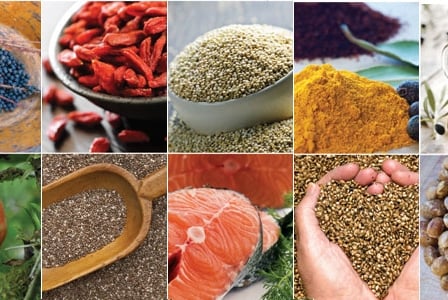
Each superfood has a unique history dating back hundreds or thousands of years. Indigenous peoples have used superfoods, such as quinoa, for centuries.
Each superfood has a unique history dating back hundreds or thousands of years. Indigenous peoples have used superfoods, such as quinoa, for centuries.
Goji
Originating in China, goji berries have been used extensively in traditional Chinese medicine. According to legend, goji berries helped one herbalist live to the ripe age of 252 years.
While the legend may not be easy to prove, recent research does show that goji may boost immunity and relieve hypertension. The antioxidant-packed berries may also have antitumour and liver-protecting properties.
Today goji is popular as a dietary supplement found at most natural health retailers.
Acai
There is good reason the dark purple berry has been traditionally used in South America for food and medicine. Research has found acai to possess potential anti-inflammatory properties, as well as high amounts of essential fatty acids, protein, and antioxidants.
Health food stores carry acai in pill, powder, and juice form.
Sacha inchi
Sacha inchi seeds are relative newcomers to the North American market. Also referred to as the “Inca peanut,” they have been traditionally used as food in South America.
Research on sacha inchi seeds concludes that their high levels of healthy fats may lower levels of harmful cholesterol (LDL) and raise levels of healthy cholesterol (HDL). They are also a complete protein containing all essential amino acids.
Quinoa
Originating in South America, quinoa is a gluten-free seed and complete protein referred to as “the mother of all grains.” The Andean people have farmed quinoa for thousands of years.
Recent animal studies suggest that quinoa may help to ward off obesity. Today quinoa is widely available in white, black, and red varieties, and can be eaten in place of rice or pasta.
Turmeric
The use of turmeric dates back 4,000 years as a staple in Ayurvedic and traditional Chinese medicine.
Research suggests that this bright yellow spice may prevent and fight cancer, treat digestive upsets, protect against pancreatitis, and reduce osteoarthritis inflammation. Its active ingredient, curcumin, acts as a potent antioxidant.
Turmeric is commonplace today as a spice (fresh as a root or dried) and is continuing to grow in popularity as a supplement.
Cacao
Cacao, the raw material of chocolate, has been used for more than 3,000 years in Mesoamerica. Ancient Mayan texts describe cacao as a gift from the gods, and it was mixed with spices to make a hot beverage. It has also reportedly been used in ancient sacrificial rituals.
Thankfully, cacao has been shown to be beneficial even without sacrifices, boasting high amounts of antioxidants, polyphenols, healthy fats, and minerals. Plus its flavonoids may protect against cardiovascular disease.
However, not all chocolate is created equal, warns Gemma Chater, a registered holistic nutritionist based in Coquitlam, BC. Look for the percentage of cacao listed on the wrapper and choose only those with 70 percent or higher.
Chia
Although chia was a food staple in pre-Columbian Mexico and South America, many North Americans have only encountered it as the seeds for the kids’ toy Chia Pet.
Lately, however, chia has experienced a revival in health food stores due to its impressive omega-3, fibre, and protein content. Chia also slows digestion and helps to balance blood sugar levels.
Wild salmon
Salmon, one of our country’s superfoods (see sidebar on page 129 for more local superfood celebrities), is used as a diet and ceremonial staple by Canada’s indigenous people, and according to Chater, is “one of the healthiest foods you can eat.”
Along with its high omega-3 content, salmon is an excellent source of protein, vitamins, and minerals. The Canadian Heart and Stroke Foundation promotes salmon as a heart-healthy option, and Canada’s Food Guide recommends two servings of fish every week. Chater adds that salmon has “the lowest amounts of contaminants (such as mercury) among seafood.”
Hemp
Likely originating in Central Asia, hemp has been cultivated for thousands of years. Although industrial hemp does not produce hallucinogenic effects, it has long been confused with marijuana.
Hemp’s essential fatty acids may help skin conditions and normalize cholesterol levels, and its antioxidant effects may prove beneficial for those with Alzheimer’s disease. It can be found in oil or seed form at health food stores.
Extra-virgin olive oil
The Mediterranean’s famed olive oil is widely available and well known for its essential fatty acid and antioxidant content, making it an essential part of the Mediterranean diet. Evidence suggests that it helps to lower blood pressure and reduce the risk of heart disease.
Fair Trade
Sadly, in the midst of a product’s mass production, workers’ wages and working conditions can be overlooked. The cacao industry, for instance, has often been thrust into the spotlight for child labour issues and hazardous working conditions.
Choosing a product with a Fair Trade certification guarantees safe working conditions, just wages, and sustainable practices. When purchasing superfoods grown overseas, choose Fair Trade certified options from your local health food store whenever possible.
Tip
A great way to incorporate cacao into your diet is by adding pure cacao nibs to granola for breakfast.
10 Canadian superfoods
These national favourites are hard to beat for amazing health benefits and a smaller carbon footprint when grown locally.
- Saskatoon berries offer a host of antioxidants.
- Flax is full of the healthy fat alpha-linolenic acid.
- Cranberries fight urinary infections and dental bacteria.
- Maple syrup boasts vitamins, minerals, and a distinct Canadian flavour.
- Sunflower seeds’ protein and polyunsaturated fat are their claim to fame.
- Squash is chock full of fibre and vitamins A and C.
- Wild rice has a nutty flavour and contains many vitamins, minerals, and healthy fats.
- Walnuts have heart-healthy omega-3s and omega-6s, plus many vitamins and minerals.
- Barley may reduce harmful cholesterol levels and balance blood sugar.
- Currants are bursting with vitamin C and antioxidants such as polyphenols.

